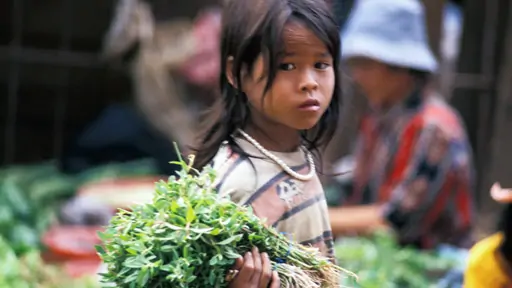Indigenous Calendar June, 2012: Child Labor or a Working Khmer Child?

The term "child labor" is one of the most emotive terms in western vocabulary. But there are differences in many parts of the world between "child labor" and "working children."
I was traveling through rural, lowland Cambodia stopping each time that either the hour grew too late or the travel conditions became unbearable. Pursat was the small town where I arrived around 7pm and that accommodated me for the night. The town is relatively unfamiliar with foreign visitors and I immediately became somewhat an enigma at my chosen hotel. The hotel staff were lining up to see if it was true that a barang had checked in for the night.
After a shower that required forty-five minutes to remove the day's dust and dirt from my hair, skin, ears, eyes and nostrils, I crossed the dusty street and entered a small, family-run restaurant. From the proprietors' immediate reaction it was clear that I was probably their first foreign customer — at least their first in a long time. They took great interest in me and suggested something to eat by bringing the ingredients out of the kitchen for me to look at! Their suggestion looked fine and there was no menu anyway!
Half-way through the meal, a young girl — probably the daughter of the proprietors — came to my table; she spoke basic English. She asked me what I was doing in Pursat. I explained my situation and mentioned photography. She recommended me to go to the town marketplace the following morning. Since I was adjusting to the slow pace of life in rural Cambodia, I was in no hurry to leave Pursat and I took her up on her advice — I even ended up borrowing her bicycle the next morning to go there.
I'd been in Cambodia for about a week but hadn't yet visited any markets. One thing that struck me immediately was the number of children working at this market. Of these children one caught my eye the most because, even though she was only around nine years old, she had the wrinkles on her forehead of a women six times her age.
She noticed me and did not object to my signed request to photograph her. After the "shoot" I approached her and gave her a small amount of money. Although it was small she was pleasantly surprised as it was probably more than she would make all day selling her herbs at the marketplace.
Cambodia is one of the poorest countries in the world and it has one of the highest rates of working children. Some children there are forced into working and the term "child labor" is accurate. This Khmer girl was helping out her family like she probably did every Sunday morning at the same marketplace. Whether the term "child labor" or "working child" applies to this scene must be judged by the viewer.
The Khmer are featured in our documentary, Indigenous Peoples of Southeast Asia.
If you enjoyed reading this article, please consider supporting independent, advertising-free journalism by buying us a coffee to help us cover the cost of hosting our web site. Please click on the link or scan the QR code. Thanks!


